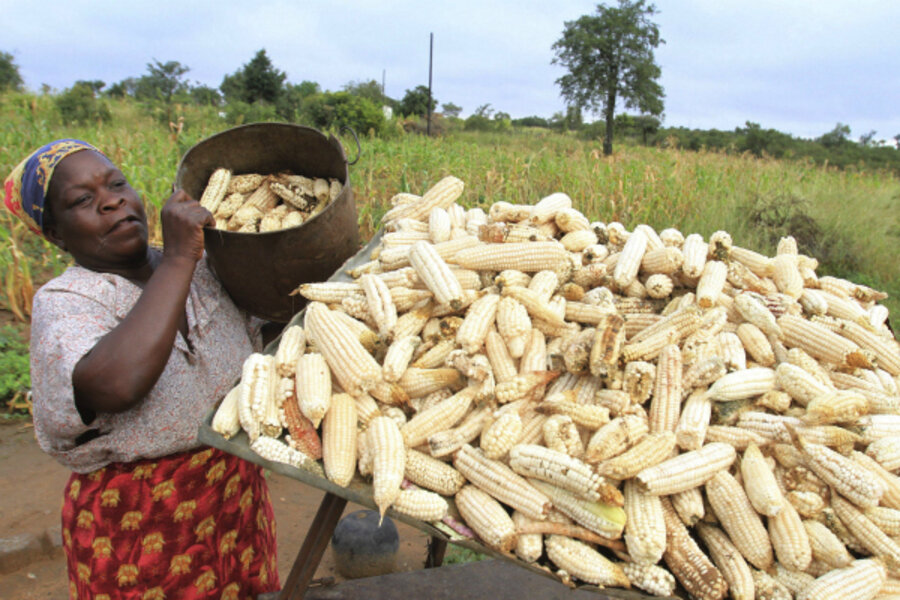Zimbabwe turns to drought-resistant crops
Loading...
| BULAWAYO, Zimbabwe
As planting season approaches amid concerns about successive poor harvests, research into drought-resistant seeds is gaining momentum in an indication that the Zimbabwean government is waking up to the reality of climate change.
Earlier this month, the country’s Meteorological Services Department announced that another drought is likely during what should be the rainy season.
Zimbabwean farmers have suffered a succession of poor harvests with yields far below what the country needs, forcing the agriculture ministry repeatedly to revise its projections for harvests.
Farmers and their unions blame the cyclical uncertainties of their sector not only on a lack of up-to-date farming technology, but also on their inability to obtain seed varieties that can survive the low rainfall caused by climatic shifts.
Despite erratic rainfall, farmers have continued to follow traditional planting seasons. This has increased their frustration as crops wilt from lack of rain.
But this could soon change, thanks to progress by government scientists researching faster-maturing and drought-tolerant seed varieties, holding out the hope of much-needed relief for thousands of farmers across the country.
The Scientific and Industrial Research and Development Centre (SIRDC), in partnership with the University of Zimbabwe and Biotechnology Research Institute (BRI), has developed a drought-resistant variety of maize (corn) seed called Sirdamaize 113.
Farmers have had to wait between 150 and 180 days before harvesting their traditional maize crop, but the center says the new seed takes only 136 days to mature.
Thomas Ndlovu, a smallholder farmer in Nyamandlovu, some 60 km (38 miles) from Bulawayo, said the new seed was welcome news, as he has lost his crop because of successive poor rains.
“This is what we have always asked for,” Ndlovu said. “My only hope is that this seed variety is affordable to us. We have for some time now been buying seed maize outside the country because the locally produced type is expensive.”
SIRDC says research into drought-resistant maize began more than a decade ago and has cost around $200,000. The center’s current research forms part of a policy on food and nutrition security adopted by government early this year.
Already, more maize hybrids are being tested across the country as farmers prepare for the planting season.
This fresh commitment to scientific research could be a significant help in a country where smallholder farmers, who produce up to 70 percent of the country’s food, continue to face severe challenges from lack of farming inputs, absence of irrigation schemes, and poor weather-forecasting techniques.
The research comes against the backdrop of announcements by the agriculture ministry that farmers will not meet the country’s grain needs again this year. Zimbabwe’s Vulnerability Assessment Committee Survey for 2012 estimates that close to 2 million people currently need food assistance.
Dexter Savadye, director of BRI, describes Sirdamaize 113 as a response to threats to the country’s food security.
“Zimbabwe has been experiencing a cycle of droughts and this has spurred the need for research in new maize varieties,” Savadye said.
Gugulethu Ndlovu of the Zimbabwe Commercial Farmers Union welcomed the possibility of improved crop yields.
“We have always said that the country needs fresh approaches to respond to low rainfall and food insecurity,” he said.
“If the country does not invest in research and development, we are likely to complain about the same things each planting season,” added Ndlovu (who is not related to farmer Thomas Ndlovu).
“What must be done now is to make this [new maize seed variety] available to the most remote parts of the country, not [only to] benefit famers who already can afford expensive irrigation schemes.”
SIRDC is also carrying out research into mushroom farming as Zimbabwe ups its efforts to restore its position as one of southern Africa’s major food producers.
According to SIRDC, the mushroom project aims to develop high-quality oyster mushroom spawn for sale to growers, as well as spawn from indigenous edible mushrooms.
Meanwhile, the agriculture ministry’s Cotton Research Institute (CRI) is testing a new cotton seed which it says is expected to boost farmers’ yields.
Cotton, Zimbabwe’s second-largest cash crop after tobacco, has also taken a knock in the past few years due to low rainfall, hurting farmers who abandoned maize production for it as cotton became the favored cash crop.
• Madalitso Mwando is a journalist based in Harare, Zimbabwe.
• This article originally appeared at AlertNet, a humanitarian news site operated by the Thomson Reuters Foundation.
• Sign up to receive a weekly selection of practical and inspiring Change Agent articles by clicking here.





